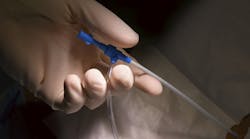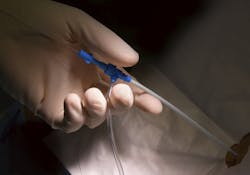One-component epoxies find use in a wide variety of medical products. Part of the reason is that the materials can be specially formulated to resist chemicals — including multiple cycles of autoclaving — while meeting rigorous biocompatibility standards. One-part epoxies also adhere well to metals, plastics, glass, and other substrates used in medical devices.
Medical-grade one-part epoxies commonly serve in disposable and reusable devices such as catheters and surgical instruments. They can also be found in orthopedic devices and in diagnostic equipment such as MRI machines and ultrasound devices.
Both one- and two-part epoxy-based systems can be used in bonding, sealing, coating, and encapsulating applications. But one-part systems have a few added benefits for medical applications. Before one can understand the nature of one-part systems, it is important to first understand two-part systems.
Two-part systems, the most basic of epoxies, are formed through the polymerization of two starting compounds: a resin and a curing agent. The curing process takes place when the reactive constituents of the resin and curing agent combine. As this reaction proceeds, an exotherm develops, enhancing the cross-linking of the two components. The speed of the reaction, plus the ultimate cured properties, both depend on the nature of the resin and the curing agent.
The majority of industrial-grade epoxies are two-part systems, which offer a comprehensive range of properties. Two-part systems require mixing and have a corresponding open time. Open time can be defined as the maximum time between mixing and the time when the product can no longer be applied. The time it takes to fully cure a two-part system can range from as little as a few hours, to as much as two weeks. Often, heat can be added, thereby accelerating curing, enhancing cross-linking, and optimizing performance properties .
With two-part systems, designers must consider a number of processing issues. First and foremost, all two-part systems have a mix ratio. Some ratios are simple one-to-one weight or volume ratios. Others are more specific and unforgiving — 100-to-7 by weight, for example. The process of mixing also requires a certain level of skill, especially when trying to ensure the two components are fully mixed. Complete mixing is as critical as avoiding air entrapment. Often, technicians mix more epoxy than is needed for the job — thereby wasting epoxy.
One-part epoxies are more efficient from a processing point of view. In a one-part epoxy, the resin and curing agent are premixed with inhibitors that prevent a reaction. The reaction only takes place when heat is added because heat eliminates these inhibitors. But it is important to heat the epoxy for the recommended cure time. Otherwise, it will only cure partially. Most one-part systems require a cure temperature of 257 to 302°F, although, there are now specialty grades for a 176°F cure. This lower curing temperature is useful for bonding heat-sensitive substrates.
Another benefit of one-part epoxies is quick curing — usually in just a couple of minutes or several hours at most. Yet, there’s often a trade-off between curing time and performance. Long-cure epoxies often offer more-advanced properties than quick-cure versions — including better electrical insulation and higher physical strength.
A point to note is storage temperature. A range of 40 to 75°F is safe for most one-part epoxies, but refrigeration is desirable in most cases. Higher storage temperatures (above 75°F) can degrade the system.
Custom-formulated one-part epoxies
Most epoxies can be modified through appropriate selection of resins and hardeners and through the addition of fillers, diluents, and other components to realize a variety of processing conditions and performance properties. While two-part epoxy systems offer the broadest array of properties and applicability among all adhesive families, one-part epoxies are also highly multifunctional.
A number of resins can be used in one-part epoxies including conventional, high temperature, and flexible, as well as low-ionic versions. The selection of a suitable curing agent is more restricted. Unlike two-part systems, which have a huge array of curing agent options, the number of compounds available to function as a curing agent in a one-part epoxy is limited.
All curing agents for one-part epoxies require heat activation and continuation of heating. If the heat is withdrawn prior to full cure, the curing process stops and the epoxy remains partially cured. In contrast, for a two-part room-temperature curing system, one can initiate curing by adding heat. This is primarily done to fixture parts together quickly. If heat is withdrawn the system will continue to cure at ambient conditions. This will not happen with a one-part system.
So why choose one-part epoxies for medical applications? Fully cured one-part epoxies offer important properties including high bond strength to a wide variety of substrates, high-performing mechanical and physical strength properties, robust temperature resistance, and the ability to withstand chemicals. One-part epoxies can be formulated in almost any viscosity imaginable. However, a paste consistency is often preferred for bonding applications to avoid material flow when heat is applied for curing. Chemical resistance, the ability to withstand high temperatures, electrical properties, optical clarity, thermal conductivity, and cure speed can also be modified to meet specific medical applications. For example, formulations are available to withstand cryogenic conditions, or to pass USP Class VI biocompatibility standards.
One significant application issue regarding one-part epoxies is that they are more exothermic than two-part systems, and in most situations, are limited by curing depths 0.25 in. or less.
Delicate devices
One-part systems are used in delicate applications like medical devices with electronics and optoelectronics. A typical use is as an underfill system, where the epoxy is designed to protect and support delicate flip chips. Important considerations would be good flow and superior dimensional stability upon curing.
Ultralow-viscosity one-part epoxies can also be used in vacuum-impregnation applications, ranging from transformer coils to carbon-fiber composites. On the other side of the spectrum, thixotropic one-part epoxies can be used as glob tops. Glob tops can be applied to circuitry, wire bonds, and even to delicate electronic components in medical equipment.
One unusual iteration of these one-part systems is epoxy films. Films are becoming increasingly used in medical applications, especially where uniform bond-line thicknesses are needed. There are a host of other applications where they are being used — lid sealing, the bonding of electronic components to heat sinks, and attaching substrates in microelectronic packages.
In addition to determining the level of biocompatibility needed, it’s important to look at several factors before choosing a one-part epoxy. Factors that may influence the selection process include cured properties, especially bonding and physical strength, chemical resistance, thermal and electrical properties, temperature resistance, thermal-cycling capabilities, and color. The handling and processing characteristics such as viscosity, exotherm, curing conditions, and temperature also play a role.
USP Class VI-approved epoxies
Medical devices must be biocompatible, which means they must be made of nontoxic materials that don’t irritate or damage living human tissue and don’t cause physiological or immune-system reactions. One stringent certification of material biocompatibility in North America is the United States Pharmacopeia (USP) Class VI. Any polymeric material that meets Class VI requirements is suitable for direct and indirect patient contact. Before granting Class VI certification, scientists test the materials by injecting and implanting material samples into subjects and then monitoring the subjects for signs of reactivity and toxicity.
Epoxies with Class VI certification are suitable for both disposable and reusable medical devices, including endoscopes and infusion pumps. These medical-grade epoxies are also useful in prosthetics and diagnostic equipment.
However, just because a material complies with USP Class VI doesn’t mean it can go in a medical device. That’s because a plethora of other FDA regulations also apply to medical devices. For example, designers that submit a device for FDA approval must also ensure that its materials undergo International Organization for Standardization (ISO) 10993 certification, which includes tests to verify compatibility with blood and bodily fluids.
Tip for engineers: If a device assembly requires the use of an epoxy to hold subcomponents together, identify the right Class VI-approved epoxy before submitting the medical device to the FDA. The industry categorizes adhesives by the number of components they mix together and how they cure. However, each type of epoxy changes with the appropriate selection of resins and hardeners and the addition of fillers, diluents, and other components.



